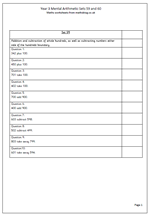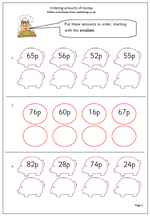 As we move towards the end of the year 3 term the mental arithmetic questions become slightly harder. These two pages of addition and subtraction questions include some quite tricky problems. The first few questions are quite straightforward with adding or subtracting multiples of 100 from 3-digit numbers, although there are many children who are not at all comfortable with larger numbers. This can often be shown by asking them to count on in whole hundreds from a given number such as 34.
As we move towards the end of the year 3 term the mental arithmetic questions become slightly harder. These two pages of addition and subtraction questions include some quite tricky problems. The first few questions are quite straightforward with adding or subtracting multiples of 100 from 3-digit numbers, although there are many children who are not at all comfortable with larger numbers. This can often be shown by asking them to count on in whole hundreds from a given number such as 34.
The last four questions look at subtraction either side of a multiple of 100. For example, at first glance 603 subtract 598 looks as if it should be done using paper and pencil methods, but it is quite easy to do by counting on.
Count on 2 from 598 to make 600. Then count on another 3 to make 603 which gives an answer of 5. No harm in using fingers to do this sort of question, especially if the question is given orally and the numbers cannot be seen.








